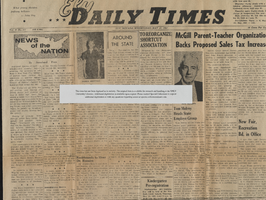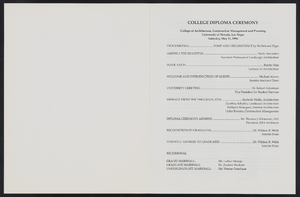Search the Special Collections and Archives Portal
Search Results
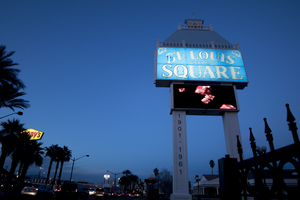
Photographs of St Louis Square sign at dusk, Las Vegas (Nev.), March 3, 2017
Date
2017-03-03
2017-09-08
Archival Collection
Description
The St. Louis Square sign sits in early evening light near the intersection of South Las Vegas Boulevard and East Louis Avenue. Information about the sign is available in the Southern Nevada Neon Survey Data Sheet.
Site address: 1945, 1921 S Las Vegas Blvd
Sign owner: St. Louis Square Inc.
Sign details: The original construction of this building was in 1987 as a shopping center. Currently this complex holds a variety of health centers.
Sign condition: 4- Has had some weathering but still in good condition
Sign form: Porte Cochere
Sign-specific description: Along Las Vegas Blvd. this Porte Cochere is placed right by the driveway to get into the parking lot with two white steel block beams as the base. There is a rectangular plasma screen that acts as a changing advertising screen. Above this there is a light blue rectangle with white plastic letters "St. Louis Square" in a subtle calligraphy font. Above this rectangle looks as though it is the light blue roof of a building, and actually matches what the roofs of the buildings in this complex.
Sign - type of display: Backlit plastic letters and LED screen
Sign - media: Steel and Plastic
Sign - non-neon treatments: Plasma screen and backlit plastic
Sign environment: Along Las Vegas Blvd. South this property in nearly across the street from the Stratosphere and about a block south of the Rummel Motel. This area is considered the transitional area between the strip and downtown.
Sign - thematic influences: Their sign relates to the property since it showcases the light blue roof which matches the buildings they have.
Sign - artistic significance: The theme of St. Louis is showcased throughout the architecture of the buildings and the sign.
Survey - research locations: Assessor's website
Surveyor: Emily Fellmer
Survey - date completed: 2017-09-08
Sign keywords: Backlit; Plastic; Steel; Plasma display; Pylon
Site address: 1945, 1921 S Las Vegas Blvd
Sign owner: St. Louis Square Inc.
Sign details: The original construction of this building was in 1987 as a shopping center. Currently this complex holds a variety of health centers.
Sign condition: 4- Has had some weathering but still in good condition
Sign form: Porte Cochere
Sign-specific description: Along Las Vegas Blvd. this Porte Cochere is placed right by the driveway to get into the parking lot with two white steel block beams as the base. There is a rectangular plasma screen that acts as a changing advertising screen. Above this there is a light blue rectangle with white plastic letters "St. Louis Square" in a subtle calligraphy font. Above this rectangle looks as though it is the light blue roof of a building, and actually matches what the roofs of the buildings in this complex.
Sign - type of display: Backlit plastic letters and LED screen
Sign - media: Steel and Plastic
Sign - non-neon treatments: Plasma screen and backlit plastic
Sign environment: Along Las Vegas Blvd. South this property in nearly across the street from the Stratosphere and about a block south of the Rummel Motel. This area is considered the transitional area between the strip and downtown.
Sign - thematic influences: Their sign relates to the property since it showcases the light blue roof which matches the buildings they have.
Sign - artistic significance: The theme of St. Louis is showcased throughout the architecture of the buildings and the sign.
Survey - research locations: Assessor's website
Surveyor: Emily Fellmer
Survey - date completed: 2017-09-08
Sign keywords: Backlit; Plastic; Steel; Plasma display; Pylon
Mixed Content
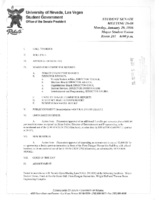
Meeting minutes for Consolidated Student Senate University of Nevada, Las Vegas, January 29, 1996
Date
1996-01-29
Archival Collection
Description
Includes meeting agenda and minutes. CSUN Session 26 Meeting Minutes and Agendas.
Text
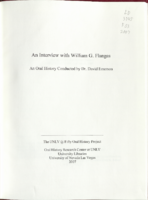
Transcript of interview with William G. Flangas by Dr. David Emerson, September 27, 2006
Date
2006-09-27
Archival Collection
Description
William Flangas was born in Ely, Nevada, in 1927. He attended grade school through high school in White Pine County. In his junior year, he left school to join the Navy. After the war, he enrolled at UNR on the G.I. Bill, and graduated with a degree in metallurgical engineering. In 1951, Bill worked for Kennecott in a 'deep root' project, spent a summer in Chile working in a smelter, and then went back to work for Kennecott in underground operations. On the basis of this experience, he wrote a thesis and earned an EM degree (Engineer of Mines). Bill was approached in 1958 by Mr. Reynolds of the Reynolds Electric/Engineering Company with a request that he come help them out at the Nevada Test Site. He refused at first, but after a second call and a visit to the tunnel site, he accepted the job, pulled together a first-rate group of experienced miners, and stayed on to enjoy a 40 year career concurrent with the job at the test site, Bill was appointed to the State Planning Board, later renamed the State Public Works Board. The function of the board was to list public buildings in order of priority. In 1984, the College of Engineering at UNLV made the priority list. Bill helped set up three point contact among the university personnel, the architectural firm, and the Public Works Board. This was to ensure that the building met the needs of the engineers but did not go over budget.
Text
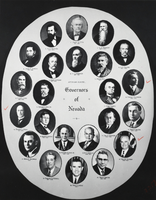
Photograph of Governors of Nevada plaque, Boulder City, Nevada, circa 1960s-1970s
Date
1960 to 1979
Archival Collection
Description
A plaque portraying the Governors of Nevada, acting and elected, in the Chamber of Commerce in Boulder City, Nevada. Description provided with image: "Pictured: 1. James W. Nye (1861-1864), 2. H.G. Blasdel (1864-1870), 3. L.R. Bradley (1871-1878), 4. John H. Kinkead (1879- 1882), 5. Jewett W. Adams (1883-1886), 6. C.C. Stevenson (1887-1890), 7. Frank Bell (1890), 8. R.K. Colcord (1891-1894), 9. John E. Jones (1895-1896), 10. Reinhold Sadler (1896-1902), 11. John Sparks (1903-1908), 12. Denver S. Dickerson (1908-1910), 13. Tasker L. Oddie (1911-1914), 14. Emmet D. Boyle (1915-1922), 15. Jas G. Scrugham (1923-1926), 16. Fred B. Balzar (1927-1934), 17. Morley Griswwold (1934), 18. Richard Kirman Sr. (1935-1938), 19. E.P. Carville (1939-1945), 20. Vail M. Pittman (1945- 1950), 21. Charles H. Russell (1951-1958), 22. Grant Sawyer (1959-1966), 23. Paul D. Laxalt (1967-)."
Image
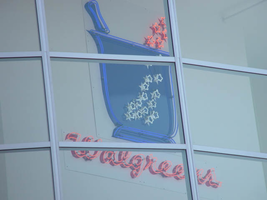
Photographs of Walgreens signs, Las Vegas (Nev.), 2002
Date
2002
Archival Collection
Description
Daytime views of the Walgreens signs on the Strip. Information about the sign is available in the Southern Nevada Neon Survey Data Sheet.
Site address: 3765 S Las Vegas Blvd
Sign condition: Structure 5 Surface 3 Lighting 5
Sign form: Fascia
Sign-specific description: The Walgreens lot is shared with the Fat Burger establishment, and a strip mall of assorted shops. The lot is located on the east side of the strip, just north of the Showcase Mall. On the west elevation of the building the Walgreen's cursive, logo script spells out the word "Walgreen's". The same sign design is repeated on the north face of the building also. The two signs are crafted out of channel letter, with blue and red neon in the interior of the channel. In small black channel letters, a bit further below the logos, there are three separate sets of much smaller channel letters. These spell the phrases "Pharmacy," "24HRS," and "1 Hour Photo." These are also lined on the interior with red and blue neon. Above the entrance to the building, a wall sign crafted of neon in the shape of the "mortar and pestle" is perched above the customers head as they enter the building from the NW. The entire structure of the image of the Walgreen's mortar and pestle, as well as the outline of the exterior stars, is constructed of one giant pan channel. The body of the pestle is made of a series of blue neon tubing which starts in the center of the pan in a square shape and creates a concentric pattern, filling the pan. Small white neon stars float to the top of the sign and into the body of the sign. Below that image, on the same elevated plane, the Walgreen's script logo is written in channel letters with white neon. Below that script is written independently in neon reading "The Pharmacy that America Trusts." Facing north /south, the street-side, pylon sign for the Walgreen's establishment is a multi-use pylon. The sign boasts advertisements for several other businesses, however the Walgreen's advertisement is the most visible and dominant on the face. The architecture of the sign is mostly a giant, stucco covered vertical rectangle with a simple crown cornice molding on the top edge of the structure. The other establishments mentioned on the sign are as read from the top of the sign to the bottom: Alan Albert's Lobster House, Club Utopia, Fatburger, and a small back-lit plastic sign for ice cream and t-shirts. At the bottom of the sign, channel letters spell the phrase parking in rear, with an arrow of the same concept pointing east toward the rear of the property. The pylon is two sided, with almost the entire top of the sign belonging to Walgreen's, and sculpted almost completely out of neon. Red, horizontal neon tubes form a field of light for the neon mortar and pestle, as seen above the entrance. The red field is also home to the cursive, Walgreen's logo script, and the phrase "Open 24 hours." The mortar and pestle are a pan channel including the stars floating out of the top incorporated into its design. Crafted in blue, with white neon for the stars, the mortar handle portion sticking out of the top of the pestle animates to appear as if it is stirring, while the stars turn on and off, representing the concoction being stirred in the body of the image. The Walgreen's script is made of channel letters filled with white neon. The bottom line of the sign that reads "Open 24 Hours," is in all caps, and channel letters with white neon on the interior. They animate in sequence one word at a time from left to right. Along the vertical edge width of the sign, the words "The Plaza" are spelled in red neon.
Sign - type of display: Neon
Sign - media: Steel
Sign - non-neon treatments: Paint
Sign animation: Chasing, flashing, oscillating
Notes: The text, which resides on the southern wall and reads "Casino," is filled with incandescent bulbs that all illuminate at the same time, and oscillate. They then shut off at the same time, and then repeat. The raceways of incandescent bulbs chase each other while the neon, which surrounds the back lit, plastic, screens on this wall flash on then off. The bottom two raceways sandwiching the reflective panel chase from left to right, while the remainder of the raceways surrounding the signs, run right to left. The incandescent bulbs on the pylon chase each other gracefully up the length of the pylon. The animation is patterned so as to appear as if a section of several bulbs are pulsing its way up the towers, hugging the edge of the bulbous tops. The raceways continue around the east face of the building. The umbrellas in the plaza behind the pylon, also are animated with incandescent bulbs chasing each other downward along the raceways.
Sign manufacturer: Mikhon lighting and sign
Sign - date of installation: 1997
Sign - thematic influences: The thematic influence of the Walgreens pylon is based on the logo for the establishment, incorporated into the architectural design of a modern commercial signage. The objects represented in the logo's are based on historical peripheral tools used in the pharmaceutical trade. The mortar and pestle were instruments used by chemists and doctors to grind and pulverize chemical to me mixed together. Since Walgreen's is a pharmacy and purveyor of commonly used goods, the mortar and pestle are appropriate symbols of the property's function.
Sign - artistic significance: Walgreen's fits into a niche of locations on the Las Vegas Strip that are establishments that can be found anywhere in the United States.
Surveyor: Joshua Cannaday
Survey - date completed: 2002
Sign keywords: Flashing; Fascia; Neon; Steel; Paint
Site address: 3765 S Las Vegas Blvd
Sign condition: Structure 5 Surface 3 Lighting 5
Sign form: Fascia
Sign-specific description: The Walgreens lot is shared with the Fat Burger establishment, and a strip mall of assorted shops. The lot is located on the east side of the strip, just north of the Showcase Mall. On the west elevation of the building the Walgreen's cursive, logo script spells out the word "Walgreen's". The same sign design is repeated on the north face of the building also. The two signs are crafted out of channel letter, with blue and red neon in the interior of the channel. In small black channel letters, a bit further below the logos, there are three separate sets of much smaller channel letters. These spell the phrases "Pharmacy," "24HRS," and "1 Hour Photo." These are also lined on the interior with red and blue neon. Above the entrance to the building, a wall sign crafted of neon in the shape of the "mortar and pestle" is perched above the customers head as they enter the building from the NW. The entire structure of the image of the Walgreen's mortar and pestle, as well as the outline of the exterior stars, is constructed of one giant pan channel. The body of the pestle is made of a series of blue neon tubing which starts in the center of the pan in a square shape and creates a concentric pattern, filling the pan. Small white neon stars float to the top of the sign and into the body of the sign. Below that image, on the same elevated plane, the Walgreen's script logo is written in channel letters with white neon. Below that script is written independently in neon reading "The Pharmacy that America Trusts." Facing north /south, the street-side, pylon sign for the Walgreen's establishment is a multi-use pylon. The sign boasts advertisements for several other businesses, however the Walgreen's advertisement is the most visible and dominant on the face. The architecture of the sign is mostly a giant, stucco covered vertical rectangle with a simple crown cornice molding on the top edge of the structure. The other establishments mentioned on the sign are as read from the top of the sign to the bottom: Alan Albert's Lobster House, Club Utopia, Fatburger, and a small back-lit plastic sign for ice cream and t-shirts. At the bottom of the sign, channel letters spell the phrase parking in rear, with an arrow of the same concept pointing east toward the rear of the property. The pylon is two sided, with almost the entire top of the sign belonging to Walgreen's, and sculpted almost completely out of neon. Red, horizontal neon tubes form a field of light for the neon mortar and pestle, as seen above the entrance. The red field is also home to the cursive, Walgreen's logo script, and the phrase "Open 24 hours." The mortar and pestle are a pan channel including the stars floating out of the top incorporated into its design. Crafted in blue, with white neon for the stars, the mortar handle portion sticking out of the top of the pestle animates to appear as if it is stirring, while the stars turn on and off, representing the concoction being stirred in the body of the image. The Walgreen's script is made of channel letters filled with white neon. The bottom line of the sign that reads "Open 24 Hours," is in all caps, and channel letters with white neon on the interior. They animate in sequence one word at a time from left to right. Along the vertical edge width of the sign, the words "The Plaza" are spelled in red neon.
Sign - type of display: Neon
Sign - media: Steel
Sign - non-neon treatments: Paint
Sign animation: Chasing, flashing, oscillating
Notes: The text, which resides on the southern wall and reads "Casino," is filled with incandescent bulbs that all illuminate at the same time, and oscillate. They then shut off at the same time, and then repeat. The raceways of incandescent bulbs chase each other while the neon, which surrounds the back lit, plastic, screens on this wall flash on then off. The bottom two raceways sandwiching the reflective panel chase from left to right, while the remainder of the raceways surrounding the signs, run right to left. The incandescent bulbs on the pylon chase each other gracefully up the length of the pylon. The animation is patterned so as to appear as if a section of several bulbs are pulsing its way up the towers, hugging the edge of the bulbous tops. The raceways continue around the east face of the building. The umbrellas in the plaza behind the pylon, also are animated with incandescent bulbs chasing each other downward along the raceways.
Sign manufacturer: Mikhon lighting and sign
Sign - date of installation: 1997
Sign - thematic influences: The thematic influence of the Walgreens pylon is based on the logo for the establishment, incorporated into the architectural design of a modern commercial signage. The objects represented in the logo's are based on historical peripheral tools used in the pharmaceutical trade. The mortar and pestle were instruments used by chemists and doctors to grind and pulverize chemical to me mixed together. Since Walgreen's is a pharmacy and purveyor of commonly used goods, the mortar and pestle are appropriate symbols of the property's function.
Sign - artistic significance: Walgreen's fits into a niche of locations on the Las Vegas Strip that are establishments that can be found anywhere in the United States.
Surveyor: Joshua Cannaday
Survey - date completed: 2002
Sign keywords: Flashing; Fascia; Neon; Steel; Paint
Mixed Content
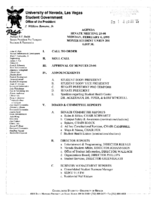
Meeting minutes for Consolidated Student Senate University of Nevada, Las Vegas, January 30, 1995
Date
1995-01-30
Archival Collection
Description
Includes meeting agenda and minutes, along with additional information about the senate bills and rules. CSUN Session 25 Meeting Minutes and Agendas.
Text
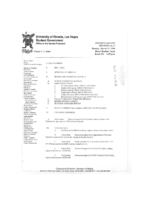
Meeting minutes for Consolidated Student Senate University of Nevada, Las Vegas, March 11, 1996
Date
1996-03-11
Archival Collection
Description
Includes meeting agenda and minutes and memos, letters and contracts. CSUN Session 26 Meeting Minutes and Agendas.
Text
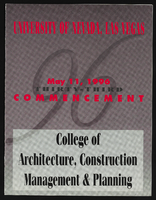
Pagination
Refine my results
Content Type
Creator or Contributor
Subject
Archival Collection
Digital Project
Resource Type
Year
Material Type
Place
Language
Records Classification

